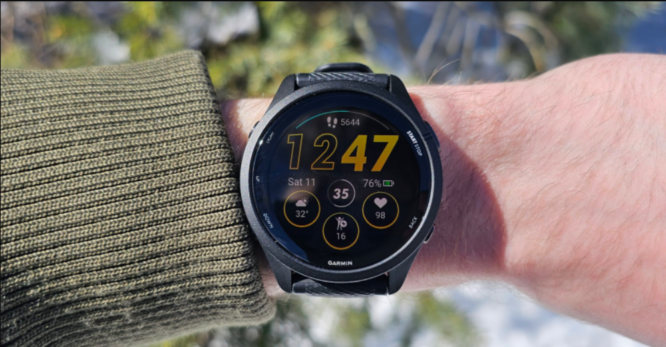I never ran. I’m active now to make up for a sedentary 20s that got me early-onset diabetes like many in my family. This year, I challenged myself to run, first in short bursts and then longer ones. Garmin asked me to review the Forerunner 265, a smartwatch for runners and triathletes. I wore this one for weeks despite not being close.
Two-tone Garmin Forerunner 265 watches have round faces. I’m testing the Whitestone version with a comfy silicone band that stays in place and doesn’t spoil with intense perspiration. Even in broad April sunlight, the 1.3-inch AMOLED display is bright and colorful enough to see everything.
Without GPS, the watch may survive a week on a single battery.
The touchscreen watch has physical buttons for menu navigation and running start/stop. Coming from a full-touch environment, this can be confusing. I struggled to figure out how to use the buttons to move and select. I think settings should allow touch-based stuff.
However, since many of its features are familiar, using this smartwatch is easy. I had trouble understanding the deep metrics for runners. The Garmin Connect software simplifies onboarding and lets you customize everything. One of the most comprehensive wristwatch apps I’ve used, with meaningful info that motivates you.

The Garmin Forerunner 265 syncs with the iPhone and Apple Health app. The Garmin Connect app collects and analyzes all watch data, including stress, breathing, and heart rate, so you won’t need to use it often. All data is viewable over 30 days.
The “body battery” metric, which measures how rested you are for the day, intrigued me. On bad sleep days, my data was negative. While I was down with Covid, the same plummeted, indicating a major issue.
I tested positive again after starting late-night walks to build up to running. Despite minimal symptoms, the doctor advised me to cease exercising for a few weeks. I wasn’t allowed to run after returning to daily walks.
The Forerunner doesn’t even offer walks as an exercise option, so you have to delve deep within the phone to select and like it. This watch has many choices for walks and swims. If you’re a hiker, the app’s Live Tracking keeps loved ones informed of your location. Garmin SATIQ and multiband GPS modes help with these and other capabilities.
That limited me to 24 hours. Run with GPS on.
The watch displays the timer, distance, pace per lap, real-time heart rate, and zone when running. Running with Apple Watch and Forerunner 265 on each arm baffled me. Apple said my lap was 11 minutes, but Garmin said 17 minutes. I realized that although the Apple Watch calculated my pace per kilometer, the Garmin was looking at an exact lap and closing the pace when I reached the same location again as per the GPS—yes, I was jogging in circles inside our gated community. A runner may regard the latter more.

The watch may load music from a PC or a streaming service app from Garmin Connect. This watch manages phone calls and messages. If you get hundreds of texts a day like me, keeping it on may not be a good idea.
I’m not criticizing the Garmin Forerunner 265’s complexity. The touchscreen and five buttons offer so many options. There are limitless ways to customize your run settings and device battery life. You just need to spend some time here to master it. I also got stuck on screens where I couldn’t get back to the homepage. It was aggravating. One-tap watch face customization would be nice.
I enjoy the morning report since it shows how well-rested you are. Then the app has tons of training options to advance your fitness or endurance. Like many other brands, the app can become a full-fledged coach with personalized insights and recommendations for free.
The Garmin Forerunner 265, at Rs 50,490, may be the most advanced running watch, but its beauty is its simplicity and its complicated data. This is only for dedicated athletes and fitness freaks because it can be overwhelming. If you run 10 miles in the morning, this is the perfect wristwatch.

